Multi-Response Optimization of Milling Process of Hardened S50C Steel Using SVM-GA Based Method
Abstract
1. Introduction
2. Materials and Methods
2.1. Workpiece and Cutting Tool
2.2. MQL, Machine Tool and Measuring Devices
2.3. Experimental Design
2.4. Research Methodology
2.4.1. Support Vector Regression
2.4.2. Non-Dominated Sorting Genetic Algorithm II (NSGA-II)
- Step 1: Population initialization: Set up the population in accordance with the scope of the issue.
- Step 2: Non-dominated sort: Sorting is performed in accordance with the population’s non-domination principles.
- Step 3: Crowding distance: The front-wise crowding distance is computed following sorting. Individuals are chosen based on rankings and crowding distances.
- Step 4: Selection: The crowded-comparison approach is used to identify individuals in binary tournaments.
- Step 5: Genetic operators: Binary crossover and polynomial mutation are used in real-coded GA.
- Step 6: Recombination and selection: The chosen members of the following generation are identified once the current generation population and offspring population have been combined. As each front succeeds in filling the new generation, the population size increases until it surpasses the existing population.
3. Results and Discussion
3.1. Regression and Experimental Results
3.2. Multi-Objective Optimization
3.3. Discussion
4. Conclusions
- The study has succeeded in proposing a plan to improve the reliability in building the regression model compared to previous studies by applying the SVR technique to obtain regression results for the model. The reliability of the regression model using the SVR algorithm is remarkably high, reaching 97.30% and 99.80% for the surface roughness and cutting force regression models, respectively.
- A hybrid method based on SVR and NSGA-II has proven reliable and could be applied in manufacturing to determine the optimal parameters. As a result of combining the SVR and NSGA-II methods in this study, an optimal set of parameters, which included Ra = 0.066 µm and F = 126.611 N, along with P = 5.503 MPa, Q = 115.504 mL/h, Vc = 188.186 m/min, fz = 0.020 mm/tooth, and ap = 0.100 mm, was suggested.
- The insignificant disparity between the results of the validation experiments and the suggested parameters demonstrates the viability and accuracy of the research. Nonetheless, it was evident that some parameters of the optimal set will inevitably fall outside the system’s control levels, making it challenging to apply the optimized cutting conditions in machining.
- The study made notable contributions to the reference data of S50C steel after heat treatment, which was known as a high-hardness material.
Author Contributions
Funding
Acknowledgments
Conflicts of Interest
References
- Richt, C. Hard turn toward efficiency. Gear Solutions, 1 April 2009, pp. 22–30. Available online: https://gearsolutions.com/features/a-hard-turn-toward-efficiency/ (accessed on 16 April 2023).
- Nguyen, T.; Hoang, T.D.; Dao, N.H.; Do Minh, H. The prediction and optimization of surface roughness in grinding of S50C carbon steel using minimum quantity lubrication of vietnamese peanut oil. J. Appl. Eng. Sci. 2021, 19, 814–821. [Google Scholar]
- Abdullah, B.; Nordin, M.F.M.; Basir, M.H.M. Investigation on CR, MRR and SR of wire electrical discharge machining (WEDM) on high carbon steel S50C. J. Teknol. 2015, 76, 109–113. [Google Scholar] [CrossRef][Green Version]
- Masmiati, N.; Sarhan, A.A.; Hassan, M.A.N.; Hamdi, M. Optimization of cutting conditions for minimum residual stress, cutting force and surface roughness in end milling of S50C medium carbon steel. Measurement 2016, 86, 253–265. [Google Scholar] [CrossRef]
- Dubey, V.; Sharma, A.K.; Vats, P.; Pimenov, D.Y.; Giasin, K.; Chuchala, D. Study of a multicriterion decision-making approach to the MQL turning of AISI 304 steel using hybrid nanocutting fluid. Materials 2021, 14, 7207. [Google Scholar] [CrossRef]
- Qazi, M.I.; Abas, M.; Khan, R.; Saleem, W.; Pruncu, C.I.; Omair, M. Experimental investigation and multi-response optimization of machinability of AA5005H34 using composite desirability coupled with PCA. Metals 2021, 11, 235. [Google Scholar] [CrossRef]
- Salur, E.; Kuntoğlu, M.; Aslan, A.; Pimenov, D.Y. The effects of MQL and dry environments on tool wear, cutting temperature, and power consumption during end milling of AISI 1040 steel. Metals 2021, 11, 1674. [Google Scholar] [CrossRef]
- Kang, M.; Kim, K.; Shin, S.; Jang, S.; Park, J.; Kim, C. Effect of the minimum quantity lubrication in high-speed end-milling of AISI D2 cold-worked die steel (62 HRC) by coated carbide tools. Surf. Coat. Technol. 2008, 202, 5621–5624. [Google Scholar] [CrossRef]
- Mia, M.; Al Bashir, M.; Khan, M.A.; Dhar, N.R. Optimization of MQL flow rate for minimum cutting force and surface roughness in end milling of hardened steel (HRC 40). Int. J. Adv. Manuf. Technol. 2017, 89, 675–690. [Google Scholar] [CrossRef]
- Mirjalili, S. Genetic algorithm. In Evolutionary Algorithms and Neural Networks; Springer: Cham, Switzerland, 2019; pp. 43–55. [Google Scholar]
- Mahesh, G.; Muthu, S.; Devadasan, S. Prediction of surface roughness of end milling operation using genetic algorithm. Int. J. Adv. Manuf. Technol. 2015, 77, 369–381. [Google Scholar] [CrossRef]
- Li, J.; Yang, X.; Ren, C.; Chen, G.; Wang, Y. Multiobjective optimization of cutting parameters in Ti-6Al-4V milling process using nondominated sorting genetic algorithm-II. Int. J. Adv. Manuf. Technol. 2015, 76, 941–953. [Google Scholar] [CrossRef]
- Selvam, M.D.; Dawood, D.; Karuppusami, D.G. Optimization of machining parameters for face milling operation in a vertical CNC milling machine using genetic algorithm. IRACST-Eng. Sci. Technol. Int. J. 2012, 2, 544–548. [Google Scholar]
- Abu-Mahfouz, I.; Banerjee, A.; Rahman, E. Evolutionary optimization of machining parameters based on surface roughness in end milling of hot rolled steel. Materials 2021, 14, 5494. [Google Scholar] [CrossRef]
- Sangwan, K.S.; Kant, G. Optimization of machining parameters for improving energy efficiency using integrated response surface methodology and genetic algorithm approach. Procedia CIRP 2017, 61, 517–522. [Google Scholar] [CrossRef]
- Sangwan, K.S.; Saxena, S.; Kant, G. Optimization of machining parameters to minimize surface roughness using integrated ANN-GA approach. Procedia CIRP 2015, 29, 305–310. [Google Scholar] [CrossRef]
- Kilickap, E.; Huseyinoglu, M.; Yardimeden, A. Optimization of drilling parameters on surface roughness in drilling of AISI 1045 using response surface methodology and genetic algorithm. Int. J. Adv. Manuf. Technol. 2011, 52, 79–88. [Google Scholar] [CrossRef]
- Kuruvila, N. Parametric influence and optimization of wire EDM of hot die steel. Mach. Sci. Technol. 2011, 15, 47–75. [Google Scholar] [CrossRef]
- Pasam, V.K.; Battula, S.B.; Madar Valli, P.; Swapna, M. Optimizing surface finish in WEDM using the Taguchi parameter design method. J. Braz. Soc. Mech. Sci. Eng. 2010, 32, 107–113. [Google Scholar] [CrossRef][Green Version]
- Zolpakar, N.A.; Lodhi, S.S.; Pathak, S.; Sharma, M.A. Application of multi-objective genetic algorithm (MOGA) optimization in machining processes. In Optimization of Manufacturing Processes; Springer: Cham, Switzerland, 2020; pp. 185–199. [Google Scholar]
- Cho, S.; Asfour, S.; Onar, A.; Kaundinya, N. Tool breakage detection using support vector machine learning in a milling process. Int. J. Mach. Tools Manuf. 2005, 45, 241–249. [Google Scholar] [CrossRef]
- Kadirgama, K.; Noor, M.; Rahman, M. Optimization of surface roughness in end milling using potential support vector machine. Arab. J. Sci. Eng. 2012, 37, 2269–2275. [Google Scholar] [CrossRef]
- Deris, A.M.; Zain, A.M.; Sallehuddin, R. Overview of support vector machine in modeling machining performances. Procedia Eng. 2011, 24, 308–312. [Google Scholar] [CrossRef][Green Version]
- Samadzadegan, F.; Soleymani, A.; Abbaspour, R.A. Evaluation of genetic algorithms for tuning SVM parameters in multi-class problems. In Proceedings of the 2010 11th International Symposium on Computational Intelligence and Informatics (CINTI), Budapest, Hungary, 18–20 November 2010; pp. 323–328. [Google Scholar]
- Chunhong, Z.; Licheng, J. Automatic parameters selection for SVM based on GA. In Proceedings of the Fifth World Congress on Intelligent Control and Automation (IEEE Cat. No. 04EX788), Hangzhou, China, 15–19 June 2004; pp. 1869–1872. [Google Scholar]
- Nguyen, T.C.; Pham, T.T.T.; Dung, H.T. Research of multi-response optimization of milling process of hardened S50C steel using minimum quantity lubrication of Vietnamese peanut oil. EUREKA Phys. Eng. 2021, 6, 74–88. [Google Scholar]
- Do, T.-V.; Hsu, Q.-C. Optimization of minimum quantity lubricant conditions and cutting parameters in hard milling of AISI H13 steel. Appl. Sci. 2016, 6, 83. [Google Scholar] [CrossRef]
- Alsoruji, G.S.; Sadoun, A.; Abd Elaziz, M.; Al-Betar, M.A.; Abdallah, A.; Fathy, A. On the prediction of the mechanical properties of ultrafine grain Al-TiO2 nanocomposites using a modified long-short term memory model with beluga whale optimizer. J. Mater. Res. Technol. 2023, 23, 4075–4088. [Google Scholar] [CrossRef]
- Najjar, I.R.; Sadoun, A.M.; Fathy, A.; Abdallah, A.W.; Elaziz, M.A.; Elmahdy, M. Prediction of Tribological Properties of Alumina-Coated, Silver-Reinforced Copper Nanocomposites Using Long Short-Term Model Combined with Golden Jackal Optimization. Lubricants 2022, 10, 277. [Google Scholar] [CrossRef]
- Vapnik, V. The Nature of Statistical Learning Theory; Springer Science & Business Media: New York, NY, USA, 1999. [Google Scholar]
- Vapnik, V.N. Statistical Learning Theory; Adaptive and Learning Systems for Signal Processing, Communications and Control; Wiley: Hoboken, NJ, USA, 1998; Volume 2, pp. 1–740. [Google Scholar]
- Datta, R.; Deb, K. A classical-cum-evolutionary multi-objective optimization for optimal machining parameters. In Proceedings of the 2009 World Congress on Nature & Biologically Inspired Computing (NaBIC), Coimbatore, India, 9–11 December 2009; pp. 607–612. [Google Scholar]
- Chen, J. Multi-objective optimization of cutting parameters with improved NSGA-II. In Proceedings of the 2009 International Conference on Management and Service Science, Beijing, China, 20–22 September 2009; pp. 1–4. [Google Scholar]
- Kodali, S.P.; Kudikala, R.; Kalyanmoy, D. Multi-objective optimization of surface grinding process using NSGA II. In Proceedings of the 2008 First International Conference on Emerging Trends in Engineering and Technology, Nagpur, India, 16–18 July 2008; pp. 763–767. [Google Scholar]
- Deb, K.; Pratap, A.; Agarwal, S.; Meyarivan, T. A fast and elitist multiobjective genetic algorithm: NSGA-II. IEEE Trans. Evol. Comput. 2002, 6, 182–197. [Google Scholar] [CrossRef][Green Version]
- Mitra, K. Multiobjective optimization of an industrial grinding operation under uncertainty. Chem. Eng. Sci. 2009, 64, 5043–5056. [Google Scholar] [CrossRef]
- Deb, K. Multi-Objective Optimisation Using Evolutionary Algorithms: An Introduction; Springer: London, UK, 2011. [Google Scholar]
- Konak, A.; Coit, D.W.; Smith, A.E. Multi-objective optimization using genetic algorithms: A tutorial. Reliab. Eng. Syst. Saf. 2006, 91, 992–1007. [Google Scholar] [CrossRef]
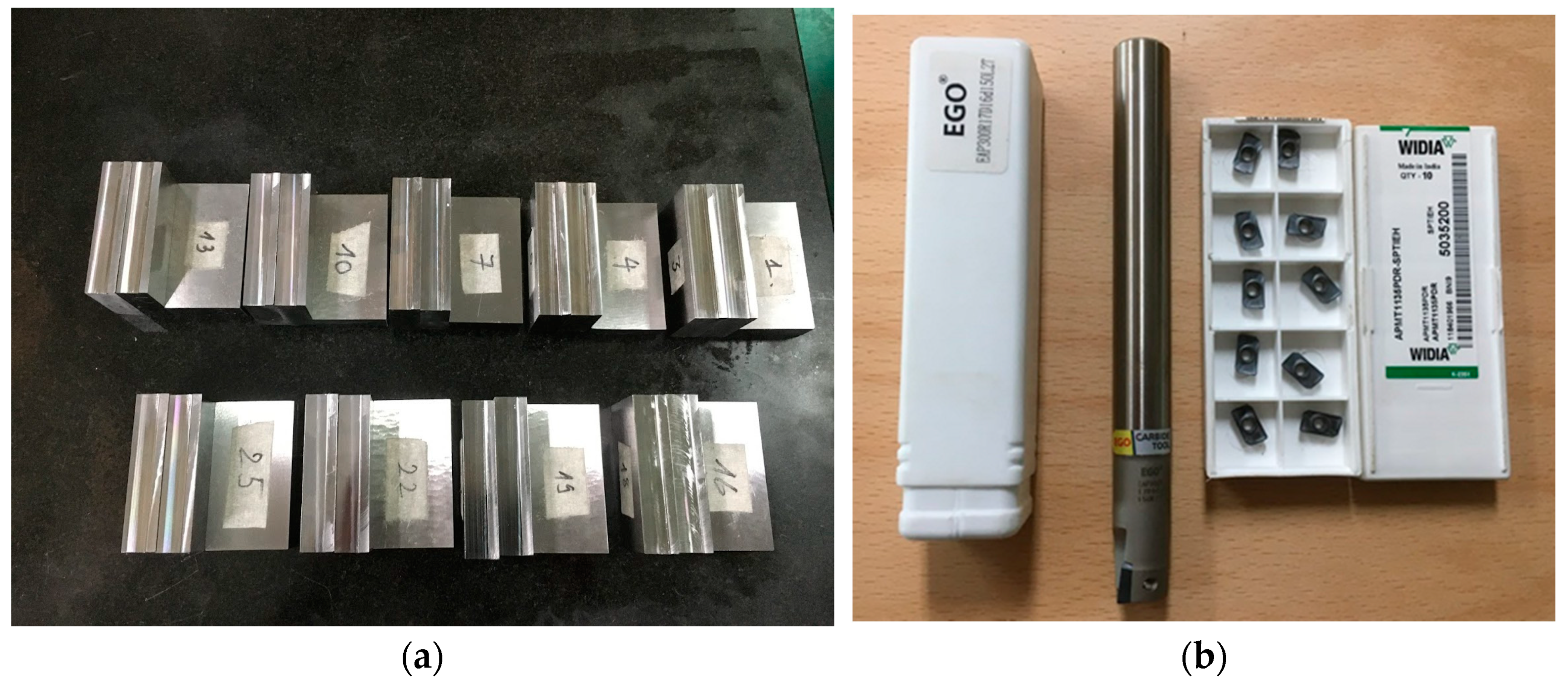
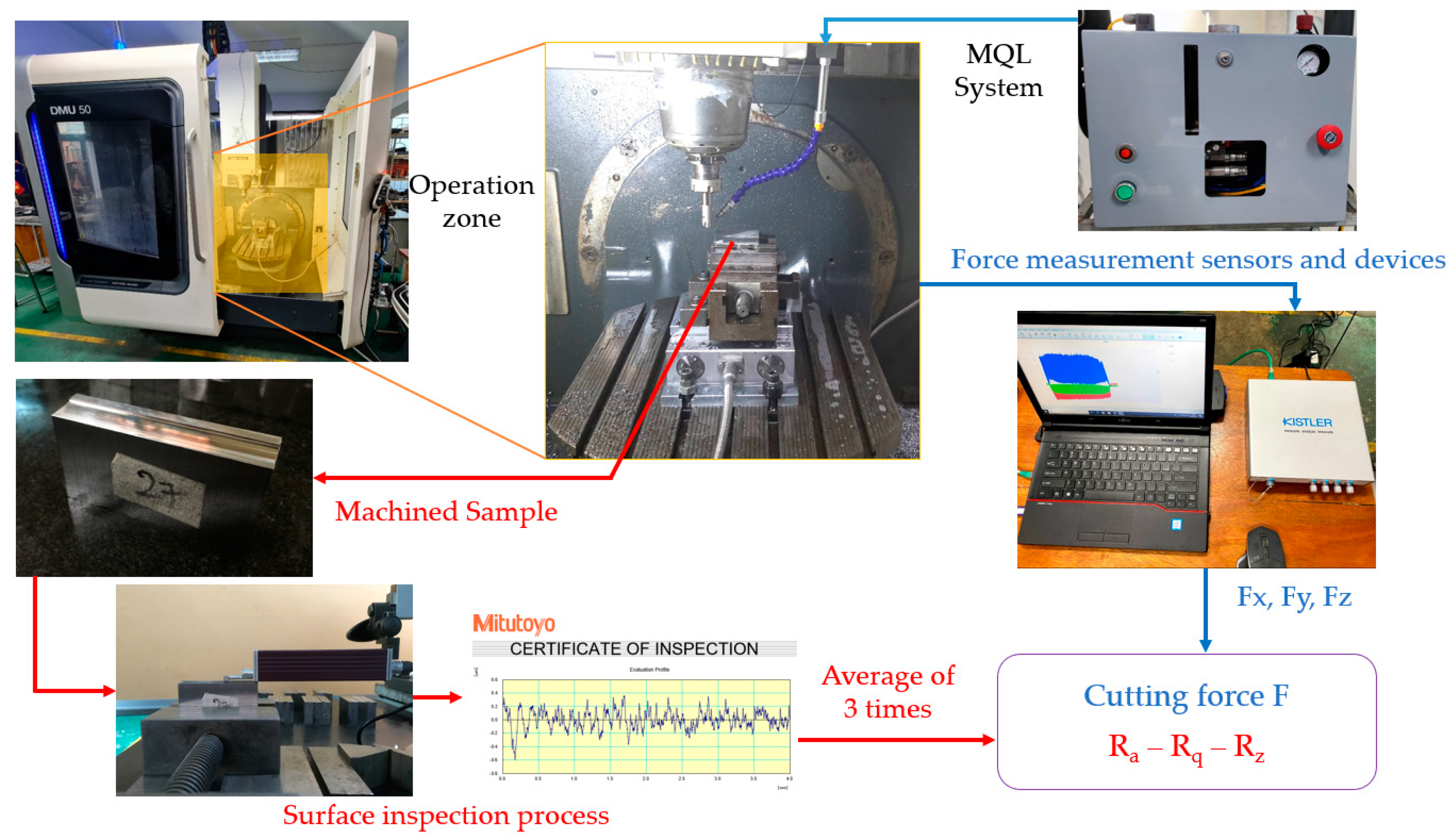
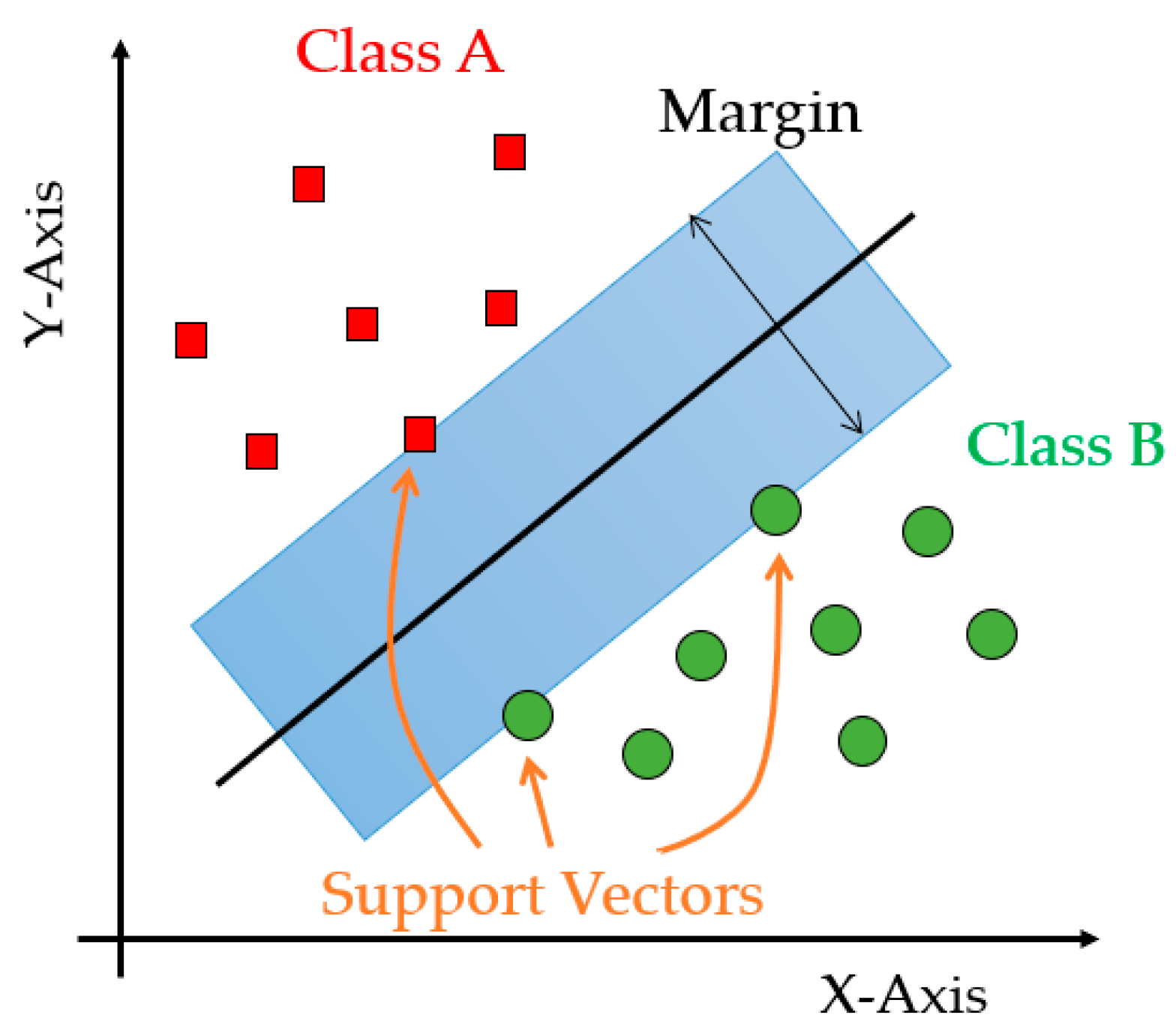



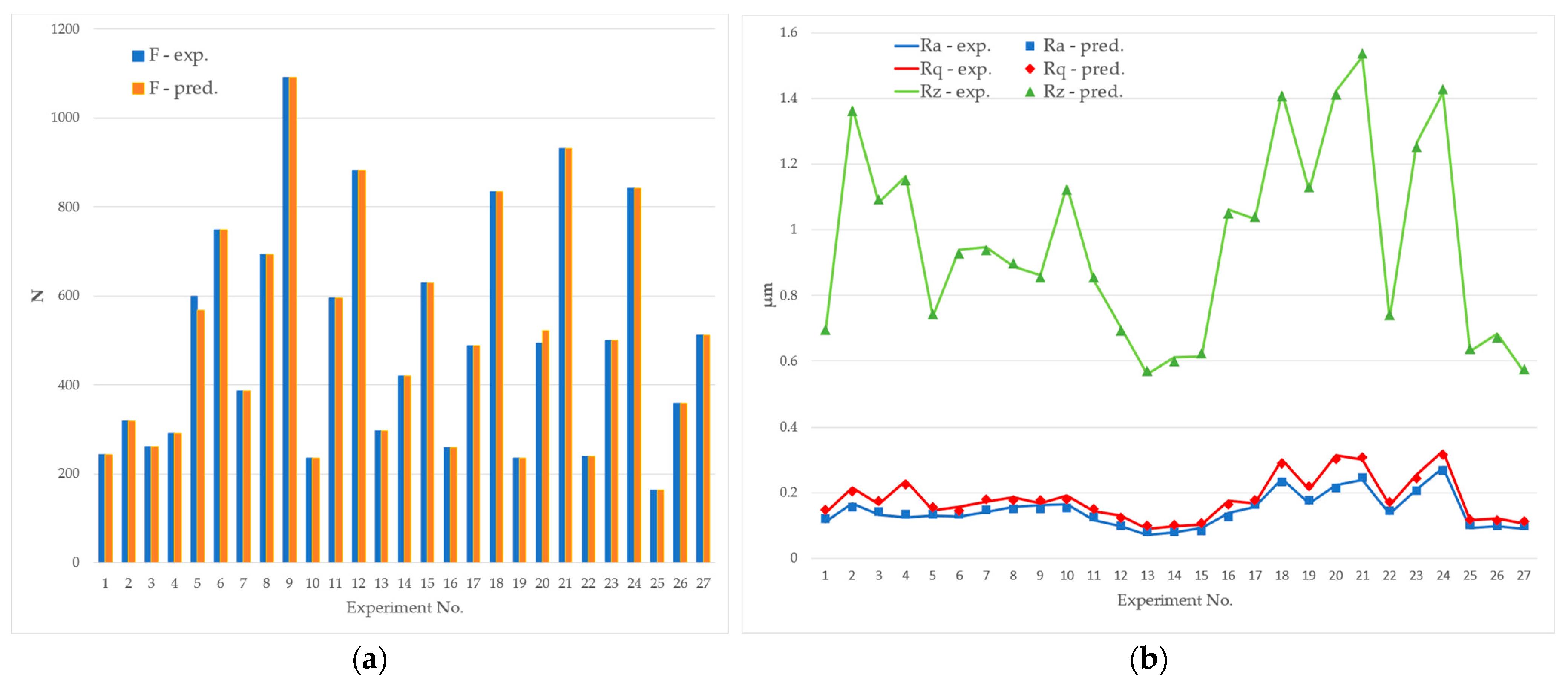
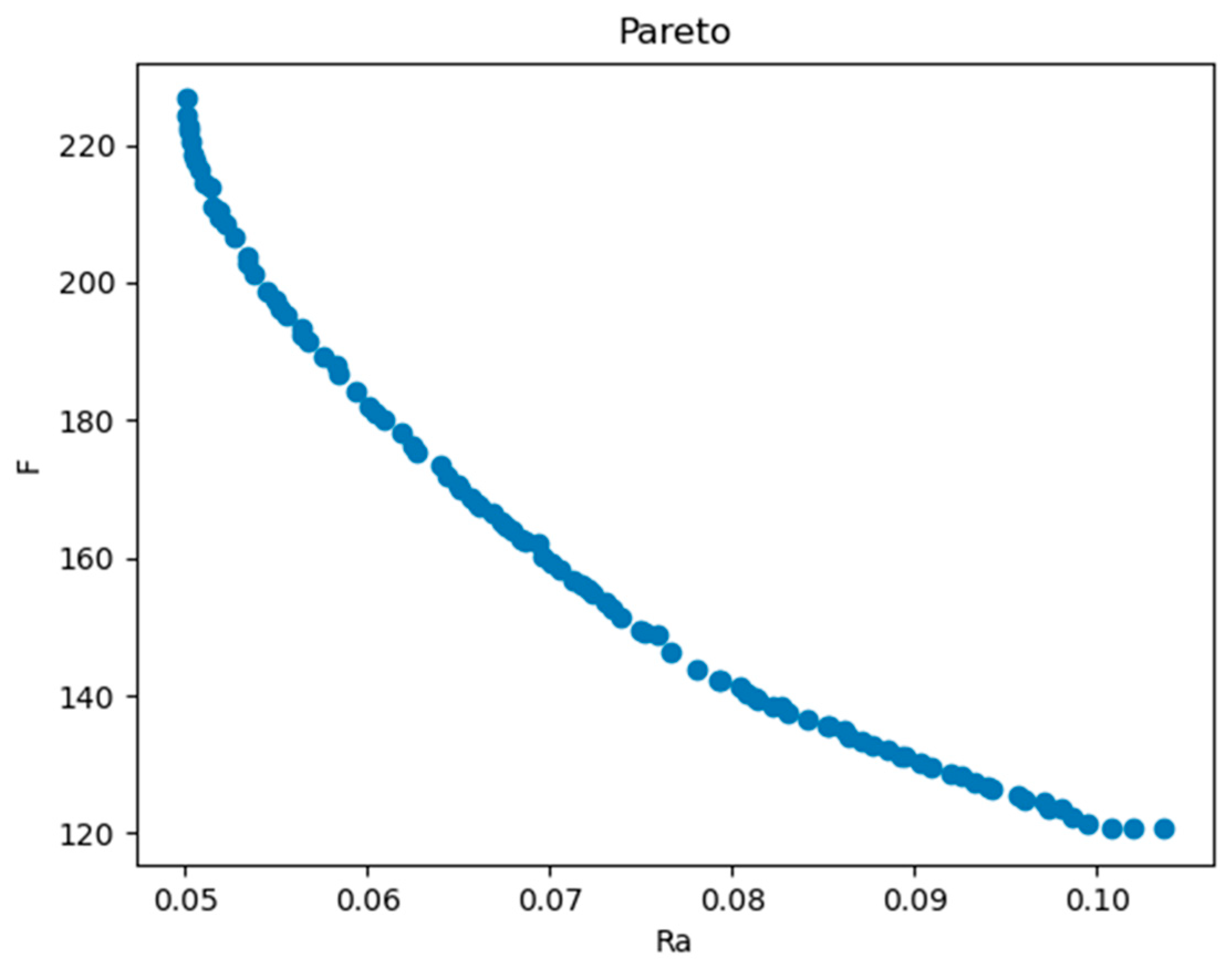
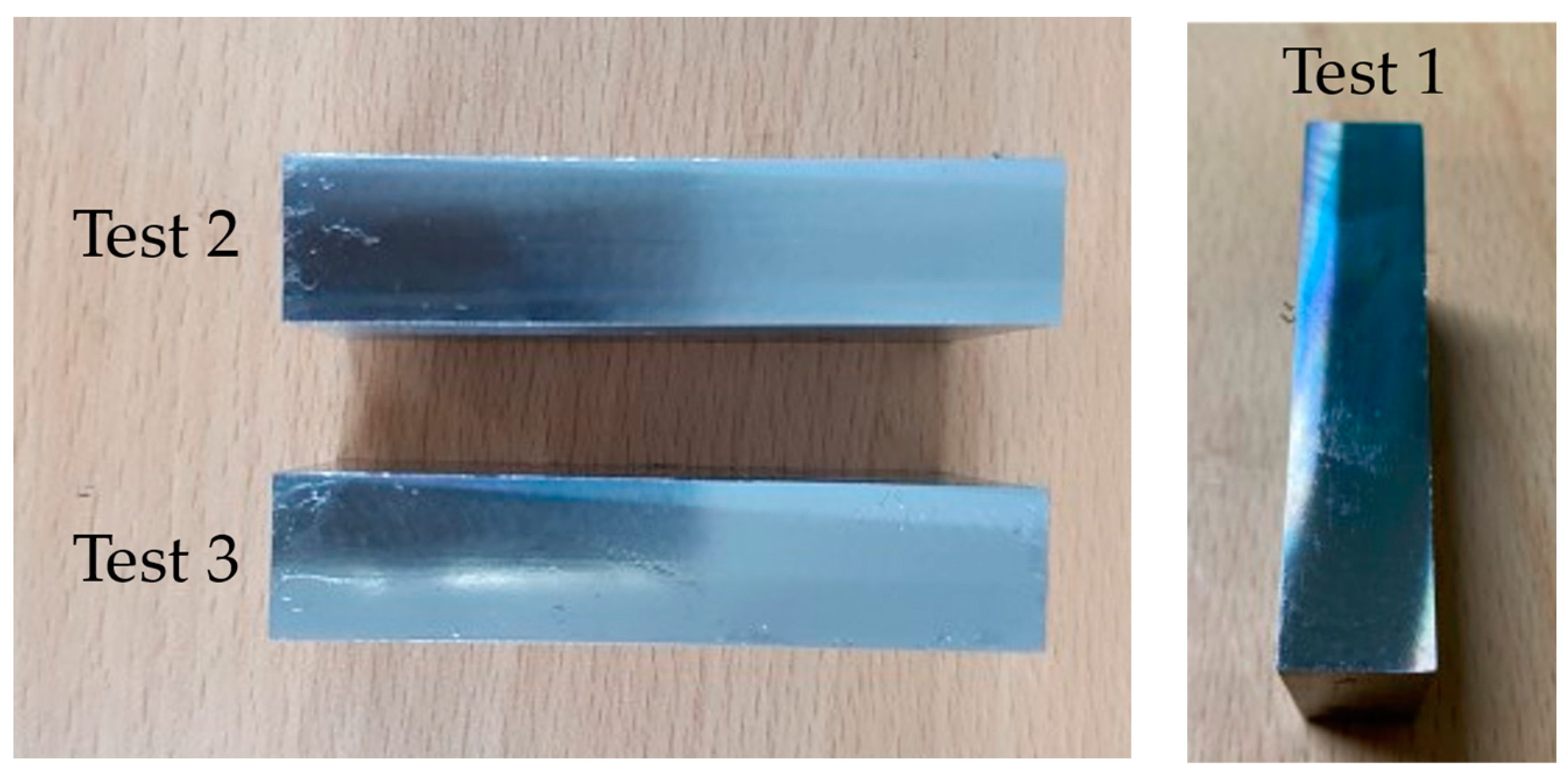
| Properties | Value | Properties | Value |
|---|---|---|---|
| Density (kg/m3) | 8000 | Thermal conductivity (W/m-k) | 47.2 |
| Poisson’s Ratio | 0.27–0.30 | Specific heat (J/kg-k) | 477 |
| Elastic Modulus (GPa) | 190–210 | Thermal expansion (1 × 10−6/K) | 16 |
| Tensile Strength (MPa) | 1588 | Melting temperature (°C) | 1370–1400 |
| Yield Strength (MPa) | 1034 | Service temperature (°C) | 0–500 |
| JIS S50C | |||
|---|---|---|---|
| Carbon, C | 0.47–0.53% | Ni + Cr | ≤0.35% |
| Silicon, Si | 0.15–0.35% | Nickel, Ni | Max 0.2% |
| Manganese, Mn | 0.6–0.9% | Chromium, Cr | Max 0.2% |
| Phosphorus, P | Max 0.03% | Bronze, Cu | Max 0.3% |
| Sulfur, S | Max 0.035% | ||
| Parameter | Level 1 | Level 2 | Level 3 | |
|---|---|---|---|---|
| −1 | 0 | 1 | ||
| Cutting velocity, m/min | Vc | 120 | 210 | 300 |
| Feed rate, mm/tooth | fz | 0.02 | 0.06 | 0.1 |
| Axial depth of cut, mm | ap | 0.1 | 0.5 | 0.9 |
| Pressure, MPa | P | 2 | 4 | 6 |
| Flow rate, mL/h | Q | 50 | 100 | 150 |
| Exp. No. | Input Parameters | Experimental | SVR Model’s Output | ||||||||||
|---|---|---|---|---|---|---|---|---|---|---|---|---|---|
| P | Q | Vc | fz | ap | Ra (µm) | Rq (µm) | Rz (µm) | F (N) | Ra (µm) | Rq (µm) | Rz (µm) | F (N) | |
| 1 | 2 | 50 | 120 | 0.02 | 0.1 | 0.112 | 0.137 | 0.687 | 242.586 | 0.123 | 0.148 | 0.697 | 242.595 |
| 2 | 2 | 50 | 120 | 0.02 | 0.5 | 0.167 | 0.215 | 1.374 | 319.611 | 0.157 | 0.205 | 1.364 | 319.600 |
| 3 | 2 | 50 | 120 | 0.02 | 0.9 | 0.132 | 0.165 | 1.083 | 261.855 | 0.142 | 0.175 | 1.093 | 261.866 |
| 4 | 2 | 100 | 210 | 0.06 | 0.1 | 0.124 | 0.236 | 1.162 | 291.262 | 0.134 | 0.226 | 1.152 | 291.272 |
| 5 | 2 | 100 | 210 | 0.06 | 0.5 | 0.130 | 0.147 | 0.736 | 600.379 | 0.134 | 0.157 | 0.746 | 568.550 |
| 6 | 2 | 100 | 210 | 0.06 | 0.9 | 0.128 | 0.156 | 0.939 | 747.921 | 0.134 | 0.146 | 0.929 | 747.930 |
| 7 | 2 | 150 | 300 | 0.10 | 0.1 | 0.142 | 0.171 | 0.948 | 386.382 | 0.150 | 0.180 | 0.938 | 386.371 |
| 8 | 2 | 150 | 300 | 0.10 | 0.5 | 0.156 | 0.186 | 0.889 | 694.077 | 0.150 | 0.179 | 0.899 | 694.089 |
| 9 | 2 | 150 | 300 | 0.10 | 0.9 | 0.161 | 0.168 | 0.861 | 1091.768 | 0.151 | 0.178 | 0.858 | 1091.757 |
| 10 | 4 | 50 | 210 | 0.10 | 0.1 | 0.165 | 0.192 | 1.134 | 234.290 | 0.155 | 0.182 | 1.124 | 234.299 |
| 11 | 4 | 50 | 210 | 0.10 | 0.5 | 0.117 | 0.142 | 0.847 | 596.467 | 0.127 | 0.152 | 0.857 | 596.458 |
| 12 | 4 | 50 | 210 | 0.10 | 0.9 | 0.098 | 0.130 | 0.703 | 883.174 | 0.100 | 0.125 | 0.693 | 883.185 |
| 13 | 4 | 100 | 300 | 0.02 | 0.1 | 0.072 | 0.091 | 0.562 | 296.335 | 0.082 | 0.101 | 0.573 | 296.328 |
| 14 | 4 | 100 | 300 | 0.02 | 0.5 | 0.080 | 0.099 | 0.611 | 420.536 | 0.083 | 0.103 | 0.601 | 420.544 |
| 15 | 4 | 100 | 300 | 0.02 | 0.9 | 0.093 | 0.102 | 0.615 | 629.360 | 0.086 | 0.107 | 0.625 | 629.353 |
| 16 | 4 | 150 | 120 | 0.06 | 0.1 | 0.137 | 0.175 | 1.062 | 259.061 | 0.126 | 0.165 | 1.051 | 259.049 |
| 17 | 4 | 150 | 120 | 0.06 | 0.5 | 0.155 | 0.168 | 1.031 | 487.960 | 0.165 | 0.178 | 1.041 | 487.971 |
| 18 | 4 | 150 | 120 | 0.06 | 0.9 | 0.242 | 0.301 | 1.419 | 834.157 | 0.232 | 0.291 | 1.409 | 834.147 |
| 19 | 6 | 50 | 300 | 0.06 | 0.1 | 0.167 | 0.209 | 1.121 | 234.685 | 0.177 | 0.220 | 1.130 | 234.673 |
| 20 | 6 | 50 | 300 | 0.06 | 0.5 | 0.224 | 0.312 | 1.424 | 494.272 | 0.214 | 0.302 | 1.414 | 522.564 |
| 21 | 6 | 50 | 300 | 0.06 | 0.9 | 0.240 | 0.299 | 1.529 | 931.319 | 0.247 | 0.309 | 1.539 | 931.308 |
| 22 | 6 | 100 | 120 | 0.10 | 0.1 | 0.135 | 0.161 | 0.732 | 239.186 | 0.145 | 0.171 | 0.743 | 239.177 |
| 23 | 6 | 100 | 120 | 0.10 | 0.5 | 0.210 | 0.254 | 1.263 | 500.255 | 0.208 | 0.245 | 1.253 | 500.263 |
| 24 | 6 | 100 | 120 | 0.10 | 0.9 | 0.277 | 0.327 | 1.419 | 843.280 | 0.267 | 0.317 | 1.429 | 843.272 |
| 25 | 6 | 150 | 210 | 0.02 | 0.1 | 0.093 | 0.115 | 0.629 | 162.715 | 0.102 | 0.120 | 0.639 | 162.724 |
| 26 | 6 | 150 | 210 | 0.02 | 0.5 | 0.099 | 0.122 | 0.683 | 358.413 | 0.100 | 0.116 | 0.673 | 358.404 |
| 27 | 6 | 150 | 210 | 0.02 | 0.9 | 0.090 | 0.105 | 0.567 | 511.924 | 0.100 | 0.115 | 0.578 | 511.933 |
| R-score | 0.973 | 0.982 | 0.999 | 0.999 | |||||||||
| P | Q | Vc | fz | ap | Ra | F | Priority |
|---|---|---|---|---|---|---|---|
| 3.940 | 123.247 | 196.193 | 0.020 | 0.100 | 0.050 | 226.691 | Ra |
| 5.500 | 115.504 | 188.185 | 0.020 | 0.100 | 0.066 | 167.126 | Neutral 1 |
| 5.990 | 59.461 | 185.782 | 0.020 | 0.100 | 0.094 | 126.611 | F |
| Experiment | P | Q | Vc | fz | ap | Experimental Results | |
|---|---|---|---|---|---|---|---|
| Ra (µm) | F (N) | ||||||
| Test 1 | 5.500 | 119.000 | 188.185 | 0.020 | 0.100 | 0.072 | 166.190 |
| Test 2 | 5.500 | 112.000 | 188.185 | 0.020 | 0.100 | 0.077 | 163.630 |
| Test 3 | 5.500 | 112.000 | 188.185 | 0.020 | 0.100 | 0.070 | 155.477 |
| Average | 0.072 | 161.766 | |||||
| NSGA-II Results | 0.066 | 167.126 | |||||
| Error | 8.94% | 3.21% | |||||
Disclaimer/Publisher’s Note: The statements, opinions and data contained in all publications are solely those of the individual author(s) and contributor(s) and not of MDPI and/or the editor(s). MDPI and/or the editor(s) disclaim responsibility for any injury to people or property resulting from any ideas, methods, instructions or products referred to in the content. |
© 2023 by the authors. Licensee MDPI, Basel, Switzerland. This article is an open access article distributed under the terms and conditions of the Creative Commons Attribution (CC BY) license (https://creativecommons.org/licenses/by/4.0/).
Share and Cite
Nguyen, T.-C.; Tien, D.H.; Nguyen, B.-N.; Hsu, Q.-C. Multi-Response Optimization of Milling Process of Hardened S50C Steel Using SVM-GA Based Method. Metals 2023, 13, 925. https://doi.org/10.3390/met13050925
Nguyen T-C, Tien DH, Nguyen B-N, Hsu Q-C. Multi-Response Optimization of Milling Process of Hardened S50C Steel Using SVM-GA Based Method. Metals. 2023; 13(5):925. https://doi.org/10.3390/met13050925
Chicago/Turabian StyleNguyen, Thanh-Cong, Dung Hoang Tien, Ba-Nghien Nguyen, and Quang-Cherng Hsu. 2023. "Multi-Response Optimization of Milling Process of Hardened S50C Steel Using SVM-GA Based Method" Metals 13, no. 5: 925. https://doi.org/10.3390/met13050925
APA StyleNguyen, T.-C., Tien, D. H., Nguyen, B.-N., & Hsu, Q.-C. (2023). Multi-Response Optimization of Milling Process of Hardened S50C Steel Using SVM-GA Based Method. Metals, 13(5), 925. https://doi.org/10.3390/met13050925







